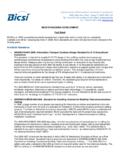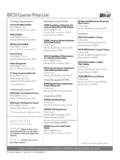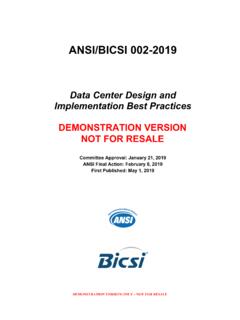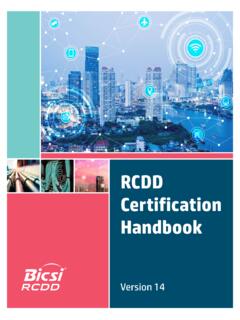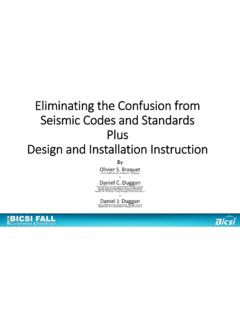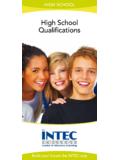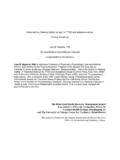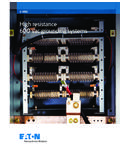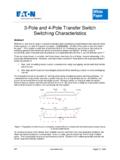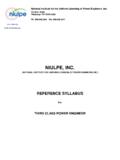Transcription of OSP Cabinets - BICSI
1 OSP CabinetsBrian L. Mordick, RCDDH offman EnclosuresAgenda Types of OSP Cabinets Wall, Pole, Pad Mounted Materials Aluminum Steel & Plated (Galvanized) Steel Composite (Polycarbonate, Fiberglass, etc) Applications WiFi, Cellular, POTS, FTTX, Security, LAN, etc Equipment Hardened vs. standard equipment Telcordia GR-487 & UL Type ratings What it is? How it influences costs Understanding Thermal Requirements to Avoid Extra Cost and to Run Greener Thermal Management techniques Insulation Color Solar shield SummaryOutside Plant (OSP) Pad-Mount Pole-Mount Exterior Wall-Mount Vaults and tunnels Roof TopsHardened vs. Standard Equipment Hardened OSP Equipment Made for high temperatures 125F Withstands vibrations & impacts Coated to withstand molds, corrosion, etc Central Office, Cellular, and Military specifications Developed to provide Highest reliability Designed for OSP applications Standard TE / IDF equipment Made for indoor controlled environments 85 95F max typical No protections for vibrations, impacts, moister, corrosion, etc The use of typical TE equipment for OSP environments is never recommended Need to provide a protected environment inside the cabinetOSP Materials Aluminum Most common material (especially for Pad mount)
2 Light weight with corrosion protection Stainless Steel Corrosion protection coastal areas Salt Food, petro chemical, water treatment, others Painted Steel Not usually used but could be for a low cost solution Not well accepted by the OSP industry. Composite Used mostly for WiFi, vaults and tunnels applications Typically smaller Wall and Pole Mounted cabinetsAluminum Pole Mount Typical OSP application 19 spaced equipment rotated to reduce width of cabinet Less load on pole Heat exchanger for thermal control Solar shield to reduce heat build-up Typical Telco equipmentComposite Pole-mount Ideal for WiFi pole-mount applications Lightweight Pole mounted applications Chemical resistant Great for Petro-chemical facilities UL Type 3R, 4.
3 4X Some are Type 6 & 6P Easy to drill cable entry holes where neededUL Type Ratings UL has several Type ratings that are commonly used for OSP Cabinets Type 3R Protects against rain and dust Not gasketed or sealed Outside air mixes with equipment Example - Outside AC breaker box Type 12 Indoor but can be used outdoor in moderate temperatures (No icing or Temps below 40F) Fully sealed from outside air penetration Type 4 Protects against icing, rain, etc Fully sealed from outside air penetration Type 4X Same as Type 4 but corrosion protections Stainless steel, Aluminum, or composite Type 6P Submersions in water Rare but some times used in tunnels and vaultsTelcordia GR-487 PopularityIn the hundreds of OSP enclosure project applications received by Hoffman every year, the de facto standard cited is frequently Telcordia GR-487 Developed by the old Bell System A good standard Performance based Recently updated Smorgasbord of tests Ala cart of testing procedures Very expense when it is embraced in its entirety, withoutexceptionsWhat s in Telcordia GR487?
4 Finish Metallic Materials Polymeric Materials Lifting Details Security/Alarms Bonding & Grounding AC Power Exposure to High Temperature Thermal Shock Water & Dust Intrusion Acoustical Noise Firearms Resistance Fire Resistance Corrosion Resistance Shock and Vibration Seismic and more All this and more! Ala Cart Only order what is neededHypothetical $8,000 Cabinet System To save capital expense: Become more discerning regarding GR487 Consider your anticipated lifespan for the deployment, the geography and climate Don t build a bullet-proof 25-year system if you don t need one$ $ $ $ $ $ $ $ $ FogTransVibeFirearmsPolymericMatlsDoes not include the Lab Testing Cost!Seismic Testing - $15,000 Exposure to High Temperature: Ambient range -40C to +46C (-40F to +115F) Allowable interior range depends on equipment Effects of solar load must be included Unmitigated This often times means an air conditioner is the only Exposure to High Temperature: Steps to mitigate the cost: Careful selection of internal electronics (choose tolerant) Consider the temperature ranges in your geography Understand the cost for worst case scenario ?
5 Insulate the cabinet interior Include solar shields Choose light colorCR3-210 Seismic Earthquake Resistance: Select Zone 4 only if you must Requires very heavy cabinet construction Inset doors (Door jam) Heavy hinges & latches Thick mounting provisions Careful selection of vibration-proof hardware Extra care at assembly and installation. Cost are significantly reduced in Zone 3 or 2 R3-203 Salt Fog: Salt Fog test is 30 days (720 hours) No visible evidence of corrosion can be present Requires costly components: Stainless steel handles & latches Stainless steel hardware on the interior (racks, etc.) NEMA and UL Type 4X is 200 hours To save costs, evaluate Your situation/ environment Intended product lifespanIs this a failure?R3-207 Transportation Vibration: Rugged test per GR63 Analogous to driving down a rail road track for 30 minutes Mitigation: Invest in a shock pallet Package critical electronic components separately inside the cabinet, install them at final destination Use special blocking inside the cabinet to be removed at final destinationR3-200 Firearms Resistance: Three levels of test: 12 GA shotgun.
6 22 Cal rifle .30 Cal rifle Material performance: .080 thick aluminum passes shotgun All practical thicknesses of aluminum Cal rifle Composites and fiberglass failshotgun Mitigation: Choose steel / stainless steel 16 gauge passes .22 Cal rifle 12 GA Cal Rifle (fail) Polymeric & Non-metallic Materials Some of the most modern, commercially acceptable polymeric materials will not pass the entire criteria Fire resistance Insect sprays UV & Ozone Mitigation: Consider your situation/environment Determine most important criteriaStandard GR-487- CORE R3 -151 Enclosure Solar Load Test With equipment running Ambient temp 115 F Illuminate on three sides with controlled light banks 70 W/sf Recorded internal temperature must be less than lowest rated componentSolar Absorption s = 1- reflectance Surface Solar Radiation ( s) absorption Polished Aluminum.
7 15 White .14 Yellow .30 Cream .25 Light Grey, Green Blue .50 Med. Grey, Green Blue .75 Dark Grey, Green Blue .95 Black .97 Thermal Requirements OSP Thermal management requirements are very demanding Wide range of environments Many alternatives Operating cost vs. up front capital costs Green initiatives Noise ordnances Equipment Hardened?Why it is important to size the Cooling System?At Extreme Shorten life of equipment Poor reliability & performance Rectifier performance is de-rated I/C based devices may experience intermittent fluctuations in output and voltage migration Mean Time Between Failure (MTBF) decreases exponentially Catastrophic failuresA Digital Equipment Corporation Study shows, For every 18 F (10 C) rise above normal room temperature, the life expectancy of the electronics is reduced approximately 50%Heat Transfer - BasicsHeat Transfer is a Combination of : Conduction q=kA(t1-t2)/x Convection q=hA (t1-t2) Radiation q=F1F2A T4 = x 10-9 btu/(hr-ft2- R) This CFD of a ventilated cabinet illustrates the temperature gradients of approx.
8 20 C ( 36 F) within the enclosure .M A T ERI A L BTU/ H-FT2 F (k ) ALUMINUM 117 CA RBON S T EEL 25 STA INLESS WINDOW GLASS .45 Air Film BTU/ H-FT2 F (h) Still (Free Convection) .79 - mph w ind or ft/s mph w ind or 11 ft/s 15 mph w ind or 11 ft/s mph wind or 114 ft/s Convection Air cooling How to dissipate the Heat - Watts? Equation [ WATT s= .316 X CFMx Tin F ] At Sea level (Use equation up to 4000 Ft) Air volume(CFM) The greater the air volume (CFM) the more heat removed Higher the CFM, the more heat dissipation Temperature{Delta T or T in F } The greater the temperature difference the more heat removed Referred to as Delta T ( Tin F) T the difference between the intake air and exhaust air Typical T is about 20 - 30 F Air flow, no matter how much, cannot cool below ambient!
9 Fans and Heat Exchangers can never cool below ambientWATT s = .316 x CFM x TDelta T (Tout-Tin) Temperature {Delta T or T in F } The greater the temperature difference the more heat removed Referred to as Delta T ( T in F ) T the difference between the intake air and exhaust air Tout Tin (In F) Air flow, no matter how much, cannot cool below ambient!Watts= .316 x CFM x TOrCFM=Watts / (.316 x T)Or T= Watts / (.316 x CFM)Charting {Watts = .316 x CFM x T}Watts = .316 x CFM x DeltaT 05,00010,00015,00020,00025,0000200400600 8001,0001,2001,4001,6001,8002,0002,2002, 400 CFMW atts10203030 T20 T10 T CFM=.(___Watts Heat)/( T or (Tin-Tout) x .316) [3500 Watts / (20F T x .316)]= 554 CFMT rade Off s CFM Noise Higher the CFM the more acoustic noise Direct relationship between CFM and acoustic noise Big problem in residential areas at night particularly Power usage The higher the CFM the more power consumed Money, availability, efficiency, etc T(Delta T in F) Avoid high T (Stay between 20 30 F T) Why Thermal shock, expansion and dew point Always keep internal temperatures of Cabinets above Dew point Condensation issues (Mold, corrosion, water droplets, etc)The higher the CFM or T the higher the heat dissipation!
10 Watt s > BTU s > Tons 1 Watt = BTU s (BTU/Hr) 5,000 Watts = 17,065 BTU s 1 Ton (refrigeration) = 12,000 BTU s 5 Tons (refrigeration) = 60,000 BTU s 1 Ton (refrigeration) = 3,516 Watts 5 Tons (refrigeration) = 60,000 BTU s = 17,580 WattsTypical Home AC unitIn Midwest will have 2 to 4 TON AC unit7,000 to 14,000 wattsTypical Home Electric Range240 Vac x 30 Amps7,000 wattsEquipment Data Form(Thermal Evaluation) Considerations to include in thermal evaluation: Size H x W X D (Surface area) Outdoor maximum temperature Maximum allowable internal temperature Internal heat generation Cabinet color Environmental Rating Select a cooling system that will maintain rating Added insulation R-0, R-2, R-4,R-6 Solar shieldingThermal Sizing SoftwareCalculate cooling requirement, select color and insulationUse free software toassist in calculations?
